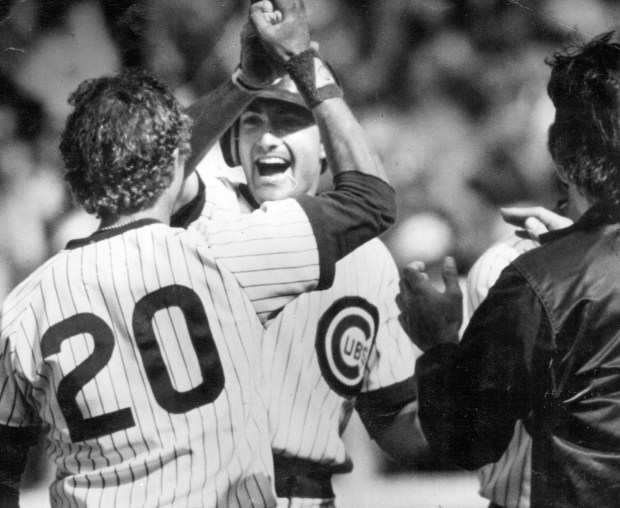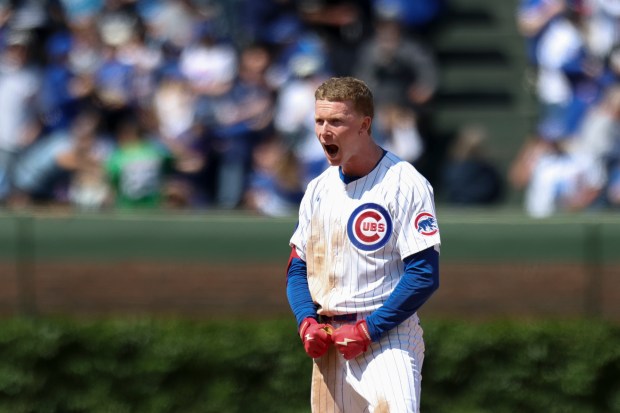No one could have guessed 40 years ago the impact one game would have.
But the “Ryne Sandberg Game” on June 23, 1984, at Wrigley Field was a game-changer in the life of the player, the trajectory of the Chicago Cubs franchise and the evolution of the Lakeview neighborhood and the North Side.
When Sandberg hit a pair of late-inning, game-tying home runs off St. Louis Cardinals closer Bruce Sutter in the Cubs’ 12-11, 11-inning win before a crowd of 38,079 at Wrigley, it signaled his rise to stardom — setting the second baseman on a course that would earn him the National League Most Valuable Player Award.
The wild, comeback win gave notice to the rest of America that the 1984 Cubs were for real despite a 39-year World Series drought and not a single championship since 1908. That game ignited an unforgettable summer run that ended with a postseason collapse in San Diego, only one game shy of the World Series.
The 1984 Cubs changed the perception of a neighborhood that once was seen as sketchy, leading local real estate agents to start calling the area Wrigleyville, a much trendier-sounding name than Lakeview East.
One game. One man. A million memories packed into nearly four hours of baseball on a hot summer day at the corner of Clark and Addison.
“So very few games have a name,” broadcaster Bob Costas told the Tribune. “There’s the Pine Tar game, which was the year before. This was a signature game of what turned out to be a Hall of Fame career.”
Where did the time go?
Forty years later, the Cubs will honor Sandberg with a statue Sunday at Gallagher Way, just outside of Wrigley Field. Costas, who made the famous “Do you believe it?” call on NBC’s “Game of the Week” in 1984, will introduce Sandberg at the ceremony, which is scheduled to begin at 3 p.m.
“Forty years, to have fans come up to me and talk about that game as if it just happened just a few years ago,” Sandberg told the Tribune. “And of course, everybody’s 40 years older, so it’s kind of a remarkable thing and it’s something that kind of grew throughout that season.
“I think it took effect as we came down the stretch and we were going to clinch the division and then even with the offseason coming, I think the fans looked back at that game as something that was very special and it was tabbed the ‘Ryne Sandberg Game.’ It just kind of happened.”
There was no reason to believe that Saturday morning that the second game of a Cubs-Cardinals series would be one to remember for generations to come. I was working for the Tribune’s city desk at the time and staggered down to Wrigley around 8 a.m. after a long night of drinking with a dozen friends from the University of Missouri. Bleacher tickets were first come, first served back in the day.
The Cubs looked like they were in their typical June swoon. After starting 30-21, they lost 10 of their next 15 entering the three-game series, falling from first to third place in the National League East, 2½ games behind the New York Mets. Sandberg was hitting .316 with seven home runs and 38 RBIs going into the series after hitting .261 with eight home runs in 1983.
His offensive improvement was promising but not jaw-dropping. No one thought of Sandberg as a possible MVP candidate in late June on a team just a handful of games over .500.
While the game was the backup “Game of the Week,” a rainout provided Costas and analyst Tony Kubek with a national TV audience.
“The ‘Game of the Week’ means something different than it does right now,” Costas said. “The ‘Game of the Week’ often would get ratings on a Saturday afternoon that prime-time shows that are considered hits would be thrilled with getting now.
“Plus you also had the perfect setting of Wrigley Field and no lights for four more years. A gorgeous Saturday afternoon. And I also think it matters that it was the Cardinals because you’d see a lot of red in the stands, just as you’d see a lot of Cubs blue at Busch Stadium.
“The cast of characters mattered as well. Whitey Herzog had a presence. Willie McGee hit for the cycle. Ozzie Smith made some typical Ozzie Smith plays. And that was the game that announced the Cubs not as lovable losers anymore but as contenders.
“And they came within a game of getting to the World Series. It wasn’t just what Sandberg did. The game itself was crazy. It was a wild game, but it was also his signature game.”
After the Cubs’ Rick Reuschel won the opener Friday, starter Steve Trout was knocked out in the second inning of Saturday’s game, and the Cubs trailed 7-1 after two. In the right-field bleachers, Cardinals fans celebrated and mocked while Cubs fans just drank, shrugged and enjoyed the sunshine.
There were no beer snakes then. Just beer. Lots of beer was drunk. And lots of beer was tossed in the air.
Trailing 9-3, the Cubs put up a five-spot in the sixth, pulling within one run on Sandberg’s two-run single off Neil Allen. It was a 9-8 game in the ninth when Herzog brought in Sutter, the former Cubs pitcher and best closer in the National League. In 45 1/3 innings over 27 outings, he had a 1.19 ERA and had allowed three home runs.
Sandberg, leading off, drilled a home run to left field on a 1-1 pitch to tie the game and turn Wrigley Field into a mosh pit of flying beer. Cubs closer Lee Smith, famous for his snail-like walk from the bullpen to the mound, entered in the 10th and served up a single to Ozzie Smith and a go-ahead double to McGee, who completed his cycle. The Cardinals added an insurance run to take a two-run lead into the bottom of the inning.
With two outs in the bottom of the 10th, Costas announced McGee as the “Player of the Game” and began reading the credits. Uh-oh.
“They all think we were giving up on the Cubs,” Costas said. “But this game ran long, even by 1980s standards, in terms of time. NBC had ‘SportsWorld’ waiting to air behind us, and Marv Albert and the ‘Fight Doctor’ (Ferdie Pacheco) were calling a fight from Panama. They were holding the opening bell. The fighters were in the dressing room waiting for the game to end, with the Cubs at bat.
“The ‘Player of the Game’ was sponsored, so we had to name one going into the bottom of the 10th. Willie had hit for cycle, the Cardinals were winning, so we named Willie McGee as the ‘Player of the Game.’ They also wanted me to read the credits because if Sandberg or the next guy makes an out, boom, we’re out of there — a hot ‘Let’s throw it to Marv Albert in Panama.’”
Bob Dernier walked with two outs on a close call by plate umpire Doug Harvey. Sandberg stepped in as the Cubs’ tying run.
“So I get the credits in right before the pitch,” Costas said.
Sandberg hit the 1-1 pitch. Sutter immediately reacted in dismay, knowing it was gone. The ball sailed deep into the left-field bleachers to tie the game again as pandemonium broke loose.
“The 1-1 pitch… left center… do you believe it?” It’s gone,” Costas said to viewers.
Even Sandberg himself could not believe it.
“Hitting two game-tying home runs off of Bruce Sutter, that was a feat that I know never happened in his career, being the dominant groundball pitcher with a pitch (the splitter) that would drop 3 feet at home plate,” he recalled. “It was just unnatural to hit, let alone elevating two balls into left field for game-tying home runs in those moments.
“It was really the only two swings that I believe in my whole career that I aimed a half a foot underneath the baseball, the reason being that we were down and there was nothing to lose in that situation and everything to gain. And that’s the plan that I went with. As it turns out, it was just something totally different that I hadn’t done before.”
Coincidentally, the baseball-themed movie “The Natural” had just been released on May 11, featuring Robert Redford as the tragic hero, slugger Roy Hobbs.
“I think I may have said something to the effect of ‘This may be the real-life Roy Hobbs with Sandberg,’” Costas recalled.
Smith retired the Cardinals in order in the 11th, and the Cubs won in the bottom of the inning on Davey Owen’s pinch-hit, bases-loaded, RBI single off reliever Jeff Lahti.
“He’s Baby Ruth,” Herzog said of Sandberg in his postgame office.
The game lasted 3 hours, 53 minutes. Both Cubs and Cardinals fans poured into the Lakeview bars afterward to either celebrate or drown their sorrows after an exhausting afternoon. The Tribune’s headline over beat writer Fred Mitchell’s story the next day read: “That’s Entertainment.”
Though McGee had the game of his life, he understood he was not really the “Player of the Game.”
“It was Ryne Sandberg’s day,” McGee said last week at Wrigley. “You hit two home runs off Bruce Sutter, you deserve it.”
To this day, Costas says people still tell him they were upset over NBC naming McGee the “Player of the Game” and for him reading the credits before the Sandberg’s second home run.
“To think any broadcaster would think the game is over with the tying run at the plate …” he said with a sigh. “And it’s already as crazy a game as anything. But people think what they want to think.”
Forty years later, the “Sandberg Game” still resonates in the heart of Wrigleyville.
The celebration continues Sunday.
Do you believe it?
Tribune reporter Meghan Montemurro contributed.




